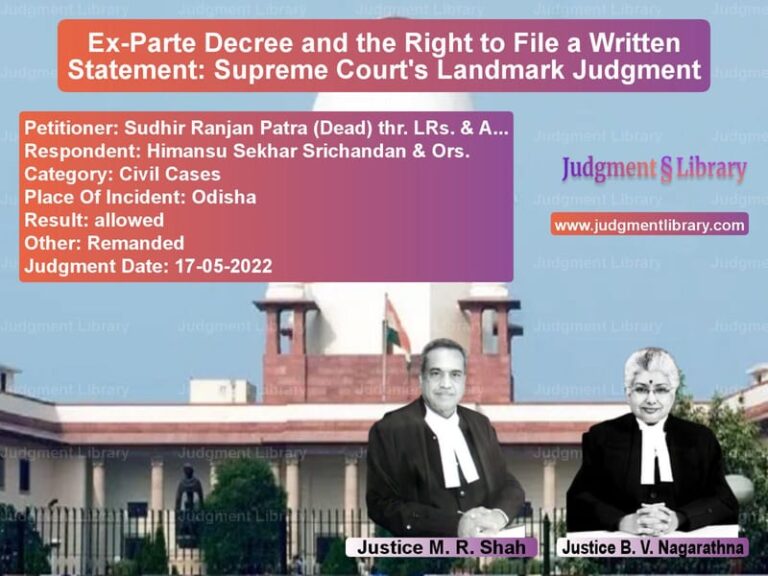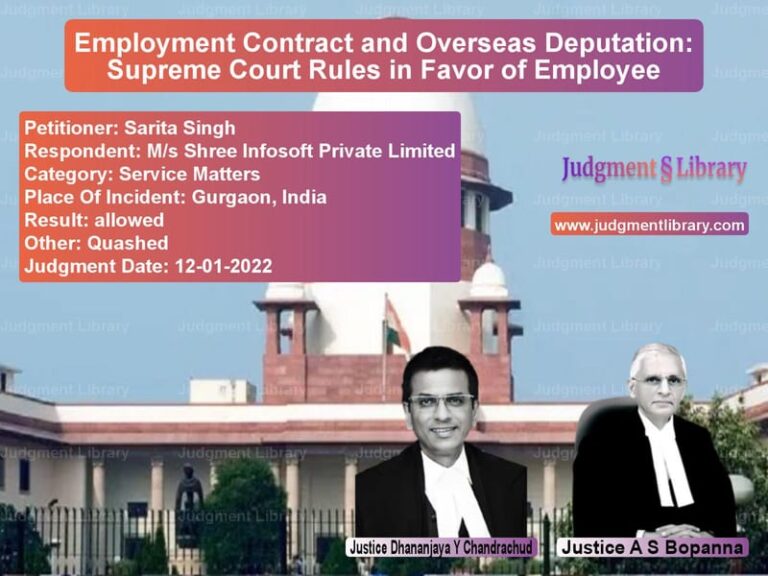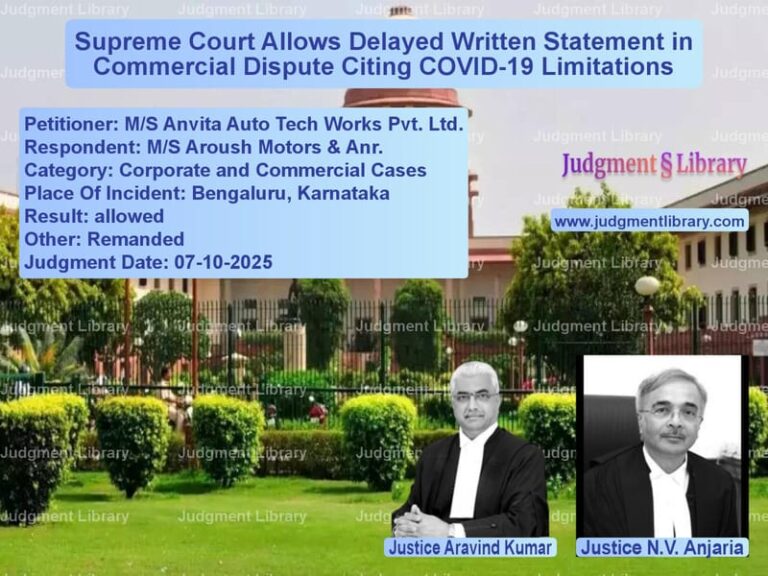Electricity Tariff Dispute: Supreme Court Upholds Regulatory Commission’s Decision
The case of Damodar Valley Corporation v. Central Electricity Regulatory Commission & Others involved a dispute over the determination of electricity tariffs under the Electricity Act, 2003. The Supreme Court upheld the decision of the Central Electricity Regulatory Commission (CERC) and the Appellate Tribunal for Electricity, dismissing the appeal of Damodar Valley Corporation (DVC). The case primarily revolved around the interpretation of Section 38 of the DVC Act and the method for calculating interest on capital and loan repayment.
Background of the Case
Damodar Valley Corporation (DVC) is a statutory body constituted under the Damodar Valley Corporation Act, 1948. It is responsible for multiple functions, including electricity generation, transmission, and distribution, as well as irrigation, water supply, and flood control in the Damodar River region.
Prior to the enactment of the Electricity Act, 2003, DVC was setting its own tariffs under Section 20 of the DVC Act. However, with the implementation of the new electricity law, CERC took suo motu action to regulate the tariff. DVC was required to file a tariff petition, and CERC passed an order determining the tariff for the period from 2004 to 2009.
DVC challenged this order before the Appellate Tribunal for Electricity (APTEL), which partially ruled in its favor and remanded the matter back to CERC for fresh consideration. Following the remand, CERC issued a revised tariff order on August 6, 2009, which was again challenged by DVC but was upheld by APTEL.
Key Issues Raised in the Appeal
In the appeal before the Supreme Court, DVC raised two primary issues:
- Whether it was entitled to additional interest on capital under Section 38 of the DVC Act.
- Whether the deduction of cumulative depreciation from the loan component was legally valid.
Arguments of the Petitioner (DVC)
DVC contended that:
- The Appellate Tribunal and CERC failed to apply Section 38 of the DVC Act correctly, which mandates the payment of interest on capital.
- The tariff should include interest on capital separately from interest on loans and return on equity.
- The regulatory authorities wrongly equated interest on capital with interest on loans and return on equity.
- The method adopted by CERC to adjust cumulative depreciation against the loan component was contrary to the Supreme Court’s ruling in Delhi Electricity Regulatory Commission v. BSES Yamuna Power Limited (2007).
- Before the enactment of the Electricity Act, 2003, all capital contributions to DVC were treated as equity. Therefore, reducing the loan amount based on cumulative depreciation was erroneous.
Arguments of the Respondents
The Central Electricity Regulatory Commission (CERC) and other respondents countered that:
- DVC had already been given the benefit of interest on capital through return on equity and interest on loans.
- The methodology adopted by CERC was consistent with the regulatory framework and tariff determination principles.
- DVC’s claim for additional interest on capital amounted to double recovery and was not permissible under the tariff regulations.
- The adjustment of cumulative depreciation against the loan was in line with prevailing regulatory practices.
Supreme Court’s Observations
The Supreme Court extensively examined the provisions of the DVC Act and the Electricity Act, 2003. The Court made the following key observations:
- Section 38 of the DVC Act remains applicable, but the claim for additional interest on capital must be evaluated within the framework of tariff regulations.
- DVC had already received the benefit of return on equity and interest on loans. Granting additional interest on capital would result in double counting.
- The methodology of adjusting cumulative depreciation to reduce the loan component was legally valid and had been followed consistently by regulatory authorities.
- DVC had not objected to the methodology in the earlier round of litigation, and the issue had already attained finality in previous rulings.
The Court categorically stated:
“The total capital to be serviced has to be equal to the value of operating assets when they are first put to commercial use. Subsequently, the loan component gets reduced on account of repayments while the equity amount remains static.”
Supreme Court’s Judgment
Based on these observations, the Supreme Court:
- Dismissed the appeal filed by DVC.
- Held that DVC was not entitled to additional interest on capital under Section 38 of the DVC Act.
- Upheld the methodology of adjusting cumulative depreciation against the loan component.
- Emphasized that tariff determination must adhere to regulatory principles and avoid duplication of cost recovery.
Impact of the Judgment
This ruling has significant implications for electricity tariff regulation in India:
- Regulatory Clarity: The judgment reinforces the authority of CERC in determining tariffs under the Electricity Act, 2003.
- Prevention of Double Recovery: It establishes that return on equity and interest on loans cannot be supplemented by additional claims for interest on capital.
- Legitimacy of Cumulative Depreciation Adjustment: The Court validated the approach of using cumulative depreciation to reduce outstanding loans, setting a precedent for future cases.
- Binding Precedent: The ruling is now a guiding principle for tariff disputes involving multi-functional entities like DVC.
Conclusion
The Supreme Court’s decision in Damodar Valley Corporation v. Central Electricity Regulatory Commission & Others is a landmark ruling in electricity law. It upholds the principles of regulatory consistency, financial prudence, and tariff rationalization. By affirming the methodology adopted by CERC and APTEL, the Court has provided clarity on the applicability of the DVC Act in the context of modern electricity regulation. This judgment ensures that electricity tariffs remain transparent, justifiable, and aligned with national regulatory objectives.
Petitioner Name: Damodar Valley Corporation.Respondent Name: Central Electricity Regulatory Commission & Others.Judgment By: Justice Ranjan Gogoi, Justice Sanjay Kishan Kaul, Justice K.M. Joseph.Place Of Incident: India.Judgment Date: 03-12-2018.
Don’t miss out on the full details! Download the complete judgment in PDF format below and gain valuable insights instantly!
Download Judgment: Damodar Valley Corpo vs Central Electricity Supreme Court of India Judgment Dated 03-12-2018.pdf
Direct Downlaod Judgment: Direct downlaod this Judgment
See all petitions in Company Law
See all petitions in Corporate Compliance
See all petitions in unfair trade practices
See all petitions in Judgment by Ranjan Gogoi
See all petitions in Judgment by Sanjay Kishan Kaul
See all petitions in Judgment by K.M. Joseph
See all petitions in dismissed
See all petitions in supreme court of India judgments December 2018
See all petitions in 2018 judgments
See all posts in Corporate and Commercial Cases Category
See all allowed petitions in Corporate and Commercial Cases Category
See all Dismissed petitions in Corporate and Commercial Cases Category
See all partially allowed petitions in Corporate and Commercial Cases Category







